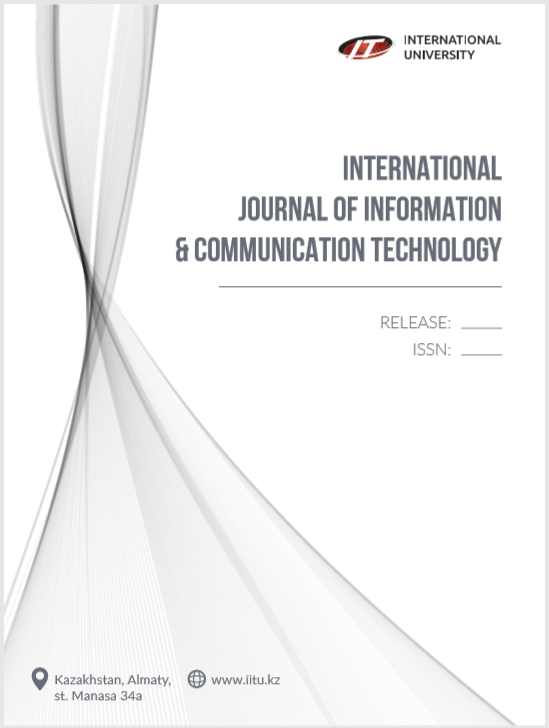Руководство для авторов
Подача статьи осуществляется через онлайн-систему сайта журнала «Электронный научный журнал «journal.iitu.edu.kz».
Статья представляется в электронном формате (в форматах .doc, .docx, .rtf) ТОЛЬКО посредством загрузки через функционал сайта журнала в профиле автора. Для этого автору необходимо зарегистрироваться на сайте журнала: journal.iitu.edu.kz (См.: Инструкция по отправке статей).
Технические характеристики статьи
Рукопись статьи должна содержать следующую информацию:
- МРНТИ статьи;
- Название статьи;
- Информация об авторах – имя, аффилиация (организация, город, страна), ORCID iD, e-mail;
- Аннотация статьи;
- Ключевые слова;
- Основной текст статьи;
- Примечания (если требуются) постраничные;
- Список литературы;
- Латинизированный список литературы «References».
Международный рубрикатор научно-технической информации (МРНТИ) – данные, которые показывают отрасль научного знания, в рамках которого выполнено исследование. Располагается в левом верхнем углу.
Ниже через строчку по центру располагается название статьи прописными буквами, полужирным шрифтом.
На следующей строке указывается информация об авторах:
Имя (ФИО полностью) строчными буквами, полужирным шрифтом по центру. Если авторов несколько, то фамилии авторов приводятся в порядке их вклада в написание статьи, при этом фамилия основного автора пишется первой. Надстрочными символами (1) и (2) обозначаются аффилиации (название организации, город, страна). А надстрочным символом в виде звездочки (*) отмечается автор-корреспондент. Например: «Ж. Досбаев1, *, Л. Илипбаева2, А. Сулиман1». Так как два автора являются представителями одной организации, они оба отмечаются надстрочным символом (1).
Через один интервал, согласно нумерации приводятся полные сведения по аффилиации (организация, город, страна). Сведения каждого надстрочного символа (1) дается отдельной строкой!
Через один интервал дается пояснение надсточному символу (*) как автор-корреспондент.
На следующей строке приводятся электронные адреса всех авторов.
Рядом с именем автора желательно указывать его ORCID iD, который проставляется гиперссылкой на iD профиль автора (см. Пример).
Аннотация – раскрывает содержание статьи, поставленную проблему и цель исследования, отражает существенные факты, основные аргументы и позицию автора, а также полученные результаты проведенного исследования. Рекомендуемый объем аннотации: 100–150 слов.
Ключевые слова – это слова, которые являются в статье наиболее значимыми и максимально точно характеризуют предмет и область исследования. Они включают основные понятия, проблемы, географические термины и другие аспекты, раскрывающие содержание статьи. В качестве ключевых слов могут использоваться одиночные слова и словосочетания. Рекомендуемое количество ключевых слов: 5–7 слов.
МРНТИ, название статьи, информация об авторах, аннотация и ключевые слова приводятся на казахском, русском и английском языках.
Основной текст статьи включает:
- Введение (актуальность проблемы исследования);
- Материалы и методы (способы достижения цели исследования);
- Обсуждение (описывается, кто занимался исследованием данной темы);
- Результаты (основная часть статьи);
- Заключение (выводы);
- Благодарности (если статья выполнена при финансовой поддержке научного фонда);
Пояснения по тексту следует выносить в постраничные примечания.
Для ссылок на источники в тексте используются круглые скобки, в которых указываются: если монография – фамилия автора, год издания и через двоеточие приводится номер использованной страницы (Аскарова, 2023: 106).
Библиографический список приводится в конце статьи в разделе «Список литературы» строго в алфавитном порядке без нумерации.
В разделе «Список литературы» литература должна быть приведена строго в алфавитном порядке без нумерации и содержать не менее 20 наименований, включать актуальные труды по теме статьи, опубликованные известными исследователями за последние несколько лет (обязательно включение источников на английском языке).
В разделе «References» приводится библиографическая информация на английском языке, транслитерация списка использованной литературы. При этом названия работ на языках, использующих нелатинизированные алфавиты, приводятся в транслитерации, то есть передаются средствами латинского алфавита, затем в скобках дается их смысловой перевод на английский язык, в конце указывается язык оригинала в квадратных скобках [In Kazakh / In Russian]. В случае цитирования книги название издательства (если это название учреждения) должно быть переведено на английский язык, во всех остальных случаях – транслитерировано, место издания – переведено.
Графики, рисунки и фотографии вставляются в текст после первого упоминания о них в удобном для автора виде со ссылкой в круглых скобках. Иллюстрации – не более 5 на одну статью. Подписи под иллюстрациями приводятся по центру после слова «Рис.» с порядковым номером. Над каждой таблицей приводится ее название после слова «Таблица» с порядковым номером. Единственный рисунок, таблица в тексте не нумеруется.
Технические характеристики:
Текст набирается в редакторе Word, шрифт Times New Roman, кегль – 12, интервал – одинарный.
Поля: верхнее и нижнее – 2 см, левое – 3 см, правое – 1 см.
Отступ первой строки абзаца – 1 см.
Страницы должны быть пронумерованы.
Объем материалов:
Для статей: максимальный объем статьи, включая аннотации, список литературы, примечания – 4000–7000 слов.
Для рецензий: максимальный объем рецензии – 500–1000 слов. Выходные данные рецензируемой книги следует приводить полностью, включая издательство, количество страниц, а также имена ответственных редакторов или составителей в случае рецензирования сборников.
Рукописи статей, оформленные не по требованиям, к публикации не принимаются.
Пример:
МРНТИ 02.10
ОБНАРУЖЕНИЕ СОБЫТИЙ НА ОСНОВЕ АУДИОСИГНАЛОВ С ПРИМЕНЕНИЕМ ГЛУБОКОГО ОБУЧЕНИЯ
Ж. Досбаев1,*, Л. Илипбаева2
1ПГУ имени С. Торайгырова, Казахстан, Павлодар;
2 Казахский национальный исследовательский технический университет имени К.И. Сатпаева, Казахстан, Алматы.
*Корреспондирующий автор
E-mail: zh.dosbayev@satbayev.university (Досбаев), l.ilipbayeva@iitu.edu.kz (Илипбаева)
Аннотация. Текст, текст, текст……
Ключевые слова: Текст, текст, текст……
Статья выполнена в рамках реализации проекта № АР…. МНВО РК.
Название статьи, информация об авторах, аннотация, ключевые слова на трех (казахском, русском и английском) языках.
Основной текст статьи:
Введение. Мәтін / Текст / Text….
Материалы и методы. Мәтін / Текст / Text…….
Обсуждение. Мәтін / Текст / Text…….
Результаты. Мәтін / Текст / Text…….
Заключение Мәтін / Текст / Text…….
Список литературы
Кулеченко К.В., Левченко А.Л. (2020). Виртуальная экскурсия, как одна из современных форм организации процесса обучения общей биологии //Сб. статей Всероссийских с международным участием студенческих Герценовских чтений «Проблемы биологического и экологического образования школьников и студентов». 2020. ―С. 72-78. [in Russ.].
Избасарова Р.Ш. (2017). Организация самостоятельной работы учащихся на уроках биологии// Наука и мир. – Волгоград. ― Т. 4. ― №3(31). ― С. 79–81. [in Russ.].
References
Almenayeva R.U., Doszhanov B.A., Kurmanbayev R.H., Tileubay S.Sh., Geldymamedova E.A. (2024). Effectiveness of using mental maps using the Mindomo mobile application in the training of biology teachers. International Journal of Educational Reform. 2024. ― 5(2), ― 297–315. https://doi.org/10.1177/105678792312247 [in Eng].

